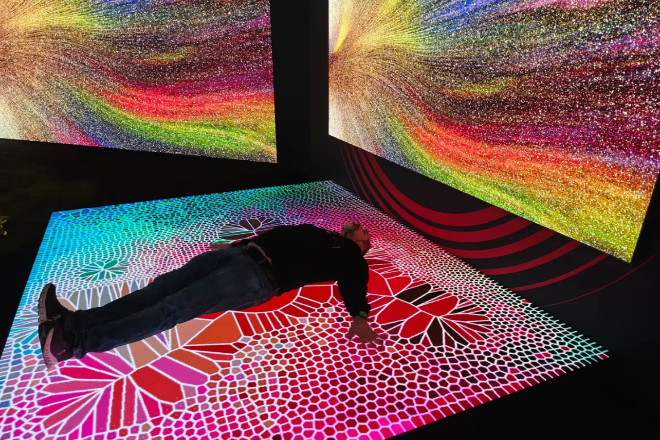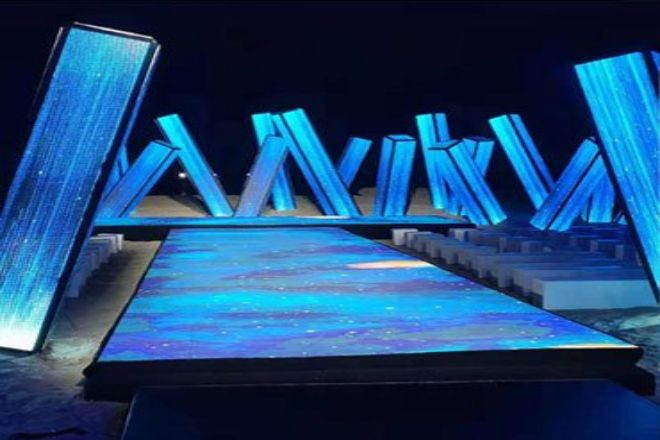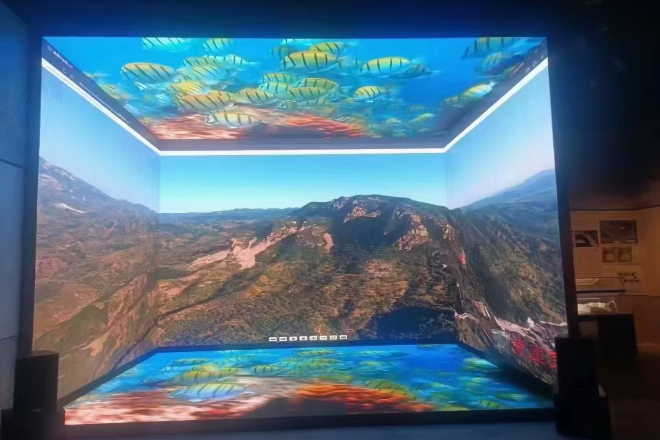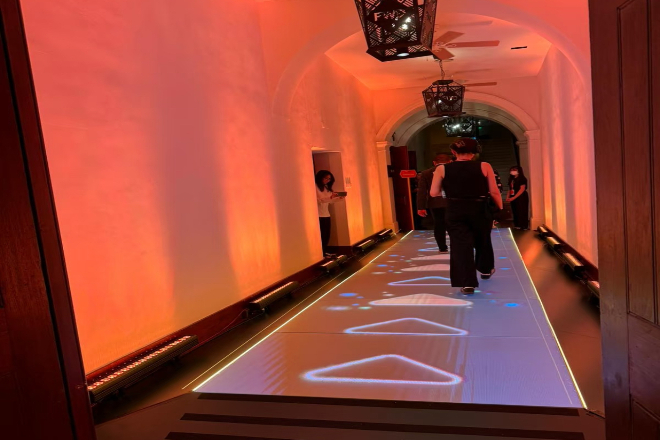소개
In the fast-paced modern life, most people are eager to escape from reality and enter a world full of fantasy and surprises.
Imagine that when you step into a space, every step is like stepping into a brand new dream: flowers bloom under your feet, light and shadow change, and the whole world interacts with you.
This is not science fiction, but an immersive experience brought by floor LED screens.
목차
1. What is the design concept of immersive interactive space?

Simply put, designing an immersive interactive space is to make users feel “fun” and “interesting”.
Designers must first figure out what users like and want to do, and then design around these needs.
For example, if users like to do it by hand, design more devices that can be touched and operated; if users like to explore, design some hidden clues or interesting tasks.
In this way, users are no longer bystanders, but can truly participate in the space and discover surprises through their own behavior.
This sense of participation and substitution will make users feel particularly enjoyable.
Imagine that you walk into a space with gorgeous pictures in front of you, beautiful music in your ears, things of different textures to touch, and even a faint fragrance.
This all-around stimulation will make you feel particularly real and interesting.
An immersive interactive space is designed to completely immerse users in it through the stimulation of multiple senses, such as vision, hearing, touch, and smell.
For example, use lights and projections to create a dreamy visual effect, add appropriate background music, and then use devices of different materials for users to touch, and even add atmosphere through fragrance, so that users can feel the charm of the space from all angles.
Interactivity is the “soul” of immersive space. Users are no longer here to watch the fun, but can truly “talk” with the space.
For example, through touch screens, gesture recognition or voice interaction, users can control the changes in the picture, the playback of music, and even interact with virtual characters.
Moreover, this interaction is not limited to the interaction between users and space, but the interaction between people is also very important.
For example, in an immersive game, everyone can team up to complete tasks together or explore together in front of interactive devices. This kind of social interaction will make the experience more interesting.
2. Application of floor LED screen in immersive interactive space

1). Flowers bloom under your feet, start a fantasy journey
Imagine that when you walk into an immersive exhibition, gorgeous flowers bloom under your feet, or ripples appear every step you take. This is the wonder of the floor LED screen.
Sensory technology can accurately capture your footsteps and generate various visual effects in real time.
For example, in an immersive space with nature as the theme, you walk on the floor screen, and there may be dense forests under your feet, and small animals shuttle around your feet.
Or it may be a clear stream with fish swimming in the water. The effect of flowers blooming under your feet makes you feel like you are in a fantasy world, and every step is full of surprises.
2). Interactive games take the experience to the next level
In an immersive space, floor LED screens can also become a large interactive game platform.
For example, in an immersive children’s park, the floor screen can be designed into various interesting games.
Children can follow the instructions on the screen, step on different patterns, complete tasks and win rewards.
This interactive game not only increases children’s sense of participation but also exercises their reaction and coordination abilities.
Moreover, this form of game is also very suitable for parent-child interaction. Parents can participate with their children and experience the fun of the game together.
3). Environment creation, enhanced immersion
The floor LED screen can also play an important role in creating the environment in the immersive space.
It can be combined with other elements in the space to create a more realistic scene.
For example, in an immersive science fiction space, the floor screen can display the starry sky of the universe, echoing the overhead lights and the projection on the wall, making you seem to be really standing in the universe.
For example, in an immersive historical space, the floor screen can restore the ancient roads or palace grounds, allowing you to experience the atmosphere of history more immersively during the visit.
4). Guide the flow of people and optimise the spatial layout
In some large immersive spaces, such as immersive theme parks or 전시회 halls, floor LED screens can also be used to guide the flow of people.
By displaying arrows, paths or prompts on the floor screen, visitors can more clearly understand their location and direction of travel.
This guidance method not only facilitates tourists but also optimises the layout of the entire space and avoids crowd congestion.
Moreover, the information on the floor screen can be changed at any time as needed, which is very flexible.
3. Implementation strategy for creating an immersive interactive space with a floor LED screen

1). Preliminary planning and design:
If you want to use a floor LED screen to create an immersive interactive space, you have to plan it well first.
First of all, you have to think clearly about the theme of this space, such as whether you want people to feel like walking in the forest or as if they are in a future world.
Once the theme is determined, there will be a direction for what content to display on the floor screen and how to interact.
For example, if it is a forest theme, patterns such as small animals, flowers and plants can appear on the floor screen.
When people step on it, the pattern can also move, just like stepping on a small animal.
Next, you need to go to the venue to measure the size and shape, think about how people will move around, and where to put the floor screen.
If there are other displays in the venue, such as projections on the wall, you also need to think about how to coordinate with the floor screen to make the whole space look more harmonious.
2). Technology selection and equipment selection:
Next, you need to choose the floor screen and related equipment. There are two types of floor screens: ordinary and interactive.
Ordinary ones simply display the picture, and interactive ones can sense people’s movements, such as changing patterns by stepping on them.
If you want to make the space more interesting, interactive floor screens are a good choice.
When choosing floor screens, you must also pay attention to several key points: the 해결 must be high enough so that the picture is clear.
The pixel spacing must be appropriate. Otherwise, the picture will look rough.
그만큼 명도 cannot be too dim. Otherwise, it will be difficult to see clearly in bright places.
Moreover, the floor screen must be able to withstand people stepping on it, and it must also have functions such as waterproofing and anti-slip, otherwise, if someone accidentally spills water or slips, it will be troublesome.
3). Interactive content development:
With floor screens, there must be fun content. The content design must be creative and in line with the theme.
For example, the floor screen in the children’s playground can be designed to display a pattern of bunnies jumping around when stepped on.
The floor screen in the science and technology museum can make people step on the virtual keyboard effect.
When making content, you must use high-quality pictures and animations, and adjust them according to the actual size of the floor screen to ensure a good display effect.
The most important thing is that the content must be able to interact with people, such as when people step on it, the pattern changes, or a sound is made, so that it can attract people and make them feel entertained.
4). System integration, installation, and debugging:
After selecting the equipment and making the content, the next step is to install them all and see the effect. First, connect the sensor and the control system.
The sensor can sense people’s movements, and the control system makes the floor screen display the corresponding content according to these movements.
When installing the floor screen, follow the instructions to ensure that the seams between the screens are smooth. Otherwise, the picture will look discontinuous.
After installation, you need to debug it carefully to see if the screen display is normal, whether the interactive effect is smooth, and whether the sensor is sensitive.
If there is a problem, you need to adjust it in time so that everything runs smoothly.
5). Operation and maintenance:
After the immersive interactive space is built, it must be operated and maintained well. Check the floor screen regularly to see if there is dust or stains, and clean it in time; check if the line is loose to prevent malfunctions.
Test whether the sensor is still sensitive. According to the information feedback from users during operation, regularly update the content on the floor screen, add new interactive elements, and keep the space fresh.
If you find that the interactive effect is not good enough, such as the screen switching is not fast enough, you must adjust and optimise it in time to ensure that users can have a good experience every time they come.
4. The future development trend of the floor LED screen to create an immersive interactive space

1). Technology upgrade:
Future floor LED screens, like mobile phones, will be more powerful with more updates.
The picture will be clearer, just like 4K TVS, and the details can be seen clearly.
Moreover, the screen may become able to “bend and twist”, no longer rigid, and can fit various strange ground shapes.
The sensing technology will also be more powerful. It can not only know that you stepped on it, but also know how you stepped on it.
For example, whether you tiptoed lightly or stomped your feet heavily, it can “understand” and then respond differently, just like it has eyes and a brain.
2). More interesting content:
In the future, floor LED screens will become particularly “intimate” and can “customise” content for you according to your preferences.
For example, it finds that you like the ocean, and the next time you walk in, there will be a sea under your feet, and there will be small fish swimming around.
Moreover, it will “work” with other things, such as playing some waves and even blowing some sea breeze, so that you feel like you are really standing on the beach.
Most importantly, it can tell stories. It is no longer a scattered picture, but a story with a beginning, a plot, and an ending.
Every step you take, the story moves forward a little, just like you are acting in a movie yourself.
3). More diverse scenes:
floor LED screens will appear in more places. In tourist attractions, such as ancient cities, it can reproduce the lively scenes of ancient streets. Walking on it is like travelling back to ancient times.
In shopping malls, it is not just a billboard, but can also become a game console, or organise various interactive activities according to brand characteristics, so that you can have fun while shopping.
In school, it can become a “magic classroom”. For example, in geography class, it can simulate earthquakes, let you feel the power of earthquakes, and make learning more interesting.
4) A more coordinated system:
In the future, floor LED screens will not “fight alone” but will “cooperate” with other screens and devices.
For example, it is linked to the screens on the wall and the ceiling so that you can see a coherent picture whether you look up, down, or around.
Moreover, it can also “play” with VR and AR devices. For example, if you wear glasses, the picture of the floor screen under your feet and the virtual picture in front of you can perfectly match, so that you can’t tell which is virtual and which is real.
5). Cost reduction:
As the technology becomes more and more mature, the price of floor LED screens will gradually drop.
Just like smartphones now, they were very expensive at first, but later everyone could afford them.
In this way, more places can use them, and they are no longer just the “patent” of large shopping malls and scenic spots.
Moreover, its maintenance will be simpler and cheaper, and there is no need to worry about not being able to afford repairs when it breaks down like now, so that more people can use it with confidence.
5. 결론
Floor LED screen is not only a technology, but also a new art form. It perfectly combines technology and creativity, bringing an unprecedented immersive experience to our lives.
Whether it is a commercial space, a cultural exhibition, or an entertainment venue, a floor LED screen can create unforgettable interactive scenes.
마지막으로 LED 디스플레이 화면에 대해 더 알고 싶다면, 우리에게 연락해주세요.
다음 내용에 관심이 있으실 수도 있습니다.
Other articles about floor LED display:
